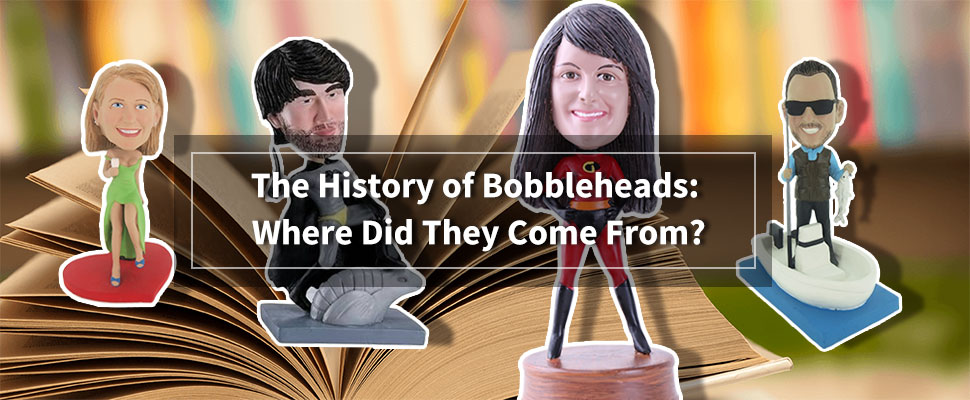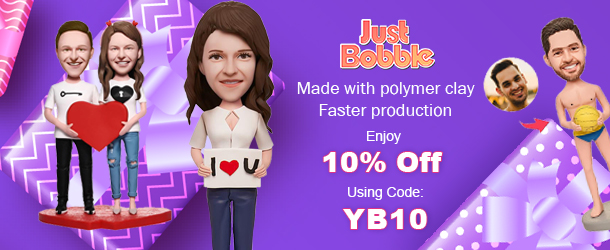Batman, fishing man, bartender, Super Woman. What do all of these figures have in common? They're bobbleheads!
In case you don't know, a bobblehead is a small doll with a disproportionately huge head. The head is attached to the body via springs. These springs make it so that when you lightly tap the head, it sways or "bobbles," hence the name. Other names for this collectible include Thanjavur, Tanjore head-shaking doll, and nodding head.
Nowadays, there is a bobblehead for pretty much any category and any person: sports, music, military, wedding, the Beatles, you name it, there is a bobblehead representation. Even Barry Manilow and Pope Benedict XVI have bobblehead versions of them. There is even a Bobblehead Hall of Fame, where thousands of bobbleheads mainly from private collections will be on display. (It is not fully complete yet.) And January 7 is National Bobblehead Day. Go figure. Conan O'Brien has a sixteen-foot bobblehead representation. We could be here for hours listing bobblehead random facts, so let's cut to the chase.
While bobbleheads are now customizable and popular, they have a rich history of popularity highs marked by lows. Also, bobbleheads used to look like cartoonish young boys and weren't nearly the promotional marketing pieces seen today. But we don't want to stop there. Here's the entire history of bobbleheads, including where they originated, how they became popular, and what sports meeting catalyzed their popularity in the United States.
Where bobbleheads came from
Bobbleheads originated from the string dolls in Japan and China. The actual, first bobblehead was made in Germany, but the first bobblehead reference can be found in a Russian short story, "The Overcoat" by Gogol.In it, one of the characters is described to look like a bobblehead. The bobblehead first went into production between the late 1700s and early 1800s.
Types of bobbleheads
While the first bobbleheads were made with ceramic, they are now produced in plastic as well. Plastic bobbleheads come in two different types: a durable and sturdy mold, and a flocked and sturdy type. The benefits of having a plastic bobblehead are that it has a unique design and is lightweight. The ceramic style, on the other hand, is more popular but is delicate.
What did bobbleheads look like
During the 50s and 60s, bobbleheads looked more like cartoonish young boys than the more real life figures we see today. Their eyes were big, cheeks chubby, and hair curled over the forehead.
From very popular to what's that name?
Bobbleheads rose to popularity during the 1960s, especially in sports. Although not sports-related, during this time the Beatles bobblehead collection became one of the most popular. (It is one of the most rare bobblehead collections of all times.) The craze ended though in the 1970s and 1980s due to the advent and popularity of other novelty items such as lunchboxes, action figurines, and video games. Many didn't believe bobbleheads would ever make a comeback, forever a relic in the twentith, twenty-first century, and beyond. This made it that much more surprising when this happened...
An unlikely twist
Alexander Malcolm would become one of the largest bobblehead sellers and a key figure in the history of bobbleheads, producing 48-49 million of these sentimental nodding heads. But he did not know it at the time when he sat down at a business meeting with the San Franciscio Giants during the 1990s. He was just hoping to sell some sort of promotional item for them. When Malcolm asked what they were looking for, The San Francisco Giants replied, "bobbleheads". Malcolm agreed to provide thousands of Willie Mays bobbleheads to the professional baseball organization to be passed out to their fans for free. Malcolm went to work, but did not know he could get away with using the traditional cartoonish boy bobblehead. Instead, he made a much more real version of Mays (although Mays would disagree). So, on May 9, 1999, to celebrate the anniversary of Candlestick Park, the last year the Giants would play at this stadium by the bay, 20,000 visitors each received the Willie Mays bobblehead. It was a success! The crowd loved the semi-life-like yet cartoonish novelty item. That one game made way for the bobblehead era revival. The next year, eight Major League Baseball teams had bobblehead giveaways. And Malcolm's small business in the 1990s flourished into the global enterprise it is today.
Bobbleheads in the beginning of the twenty-first century
Due to the San Francisco Giants' bobblehead promotion, bobbleheads went crazy. Suddenly these items did not just represent people. The mini bobbleheads, bobblehead banks, bobblehead computer sitters, and bobblehead air fresheners were born. If you could make it nod, turn it into a bobblehead seemed to be the mantra.
Why people enjoy bobbleheads—the reason they still are popular
What is it about these miniature, big-headed, nodding figures that make them not just collectible, but enjoyable? The reason: bobbleheads are real enough, but not too real. It is their whimsicalness tied with their realistic representation of a figure that has made them outlast figurines and other novelty items. It is also their connection between the industry and the fans that make them a crucial and sentimental asset. Especially with baseball, fans can increase their support by buying and collecting a nodding version of their favorite player.
From the history of bobbleheads to their future—what next?
As mentioned, because of their whimsicalness, bobbleheads will remain a staple in the collector and mainstream world, especially when it comes to baseball (their breaking out industry in the United States). It is likely that bobbleheads will remain promotional items, specifically in baseball. Bobbleheads are becoming more and more customizable. This should only increase in the upcoming years, as these items relate to everyday people (as well as the customizable trend in every other area such as food and entertainment). There are now fishing man, office, and mom bobbleheads. What are your thoughts about the history of bobbleheads or just bobbleheads in general?
Contact us if you have any comments, questions, or concerns regarding the history of bobbleheads. Please be sure to check out our custom bobbleheads as well as the sale going on.














